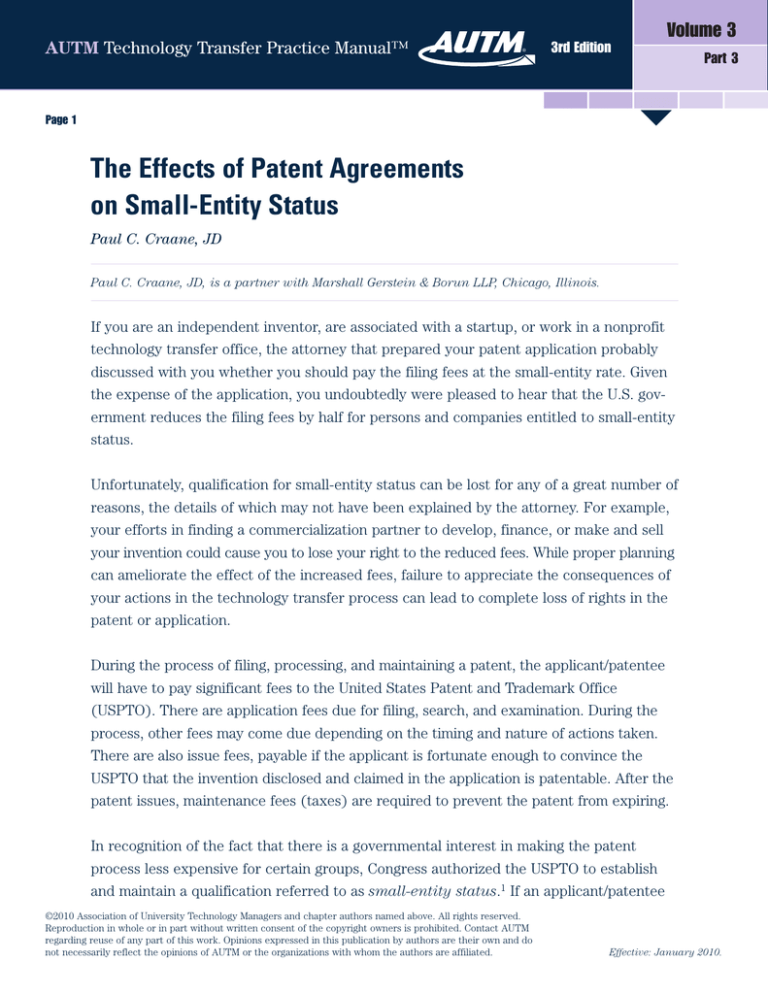
Volume 3
AUTM Technology Transfer Practice Manual™
®
3rd Edition
Part 3
Page 1
The Effects of Patent Agreements
on Small-Entity Status
Paul C. Craane, JD
Paul C. Craane, JD, is a partner with Marshall Gerstein & Borun LLP, Chicago, Illinois.
If you are an independent inventor, are associated with a startup, or work in a nonprofit
technology transfer office, the attorney that prepared your patent application probably
discussed with you whether you should pay the filing fees at the small-entity rate. Given
the expense of the application, you undoubtedly were pleased to hear that the U.S. government reduces the filing fees by half for persons and companies entitled to small-entity
status.
Unfortunately, qualification for small-entity status can be lost for any of a great number of
reasons, the details of which may not have been explained by the attorney. For example,
your efforts in finding a commercialization partner to develop, finance, or make and sell
your invention could cause you to lose your right to the reduced fees. While proper planning
can ameliorate the effect of the increased fees, failure to appreciate the consequences of
your actions in the technology transfer process can lead to complete loss of rights in the
patent or application.
During the process of filing, processing, and maintaining a patent, the applicant/patentee
will have to pay significant fees to the United States Patent and Trademark Office
(USPTO). There are application fees due for filing, search, and examination. During the
process, other fees may come due depending on the timing and nature of actions taken.
There are also issue fees, payable if the applicant is fortunate enough to convince the
USPTO that the invention disclosed and claimed in the application is patentable. After the
patent issues, maintenance fees (taxes) are required to prevent the patent from expiring.
In recognition of the fact that there is a governmental interest in making the patent
process less expensive for certain groups, Congress authorized the USPTO to establish
and maintain a qualification referred to as small-entity status.1 If an applicant/patentee
©2010 Association of University Technology Managers and chapter authors named above. All rights reserved.
Reproduction in whole or in part without written consent of the copyright owners is prohibited. Contact AUTM
regarding reuse of any part of this work. Opinions expressed in this publication by authors are their own and do
not necessarily reflect the opinions of AUTM or the organizations with whom the authors are affiliated.
Effective: January 2010.
Volume 3
AUTM Technology Transfer Practice Manual™
Page 2
®
3rd Edition
Part 3
The Effects of Patent Agreements on Small-Entity Status
Paul C. Craane, JD
is eligible for small-entity status, many fees payable to the USPTO are reduced by 50 percent. Given the sizable maintenance fees (taxes) due after grant, small-entity status may
end up being worth in excess of $5,000 in savings over the life of a single patent.
There is a downside: Paying a fee at the small-entity rate when the party is not eligible to
qualify for small-entity status may render the patent unenforceable.2 According to the
courts, it is not merely sufficient that the fee be paid incorrectly, there must be an intent
to deceive the USPTO as well.3 The intent may be inferred from circumstances, and at
least one court has inferred the intent, at least in part, from an attorney's failure to abide
by the USPTO’s guidance as provided in the Manual of Patent Examining Procedure (MPEP).4
So why not just pay the normal fees, regardless of actual eligibility for small-entity status?
Canadian patent practitioners routinely advise their clients to pay at the normal entity
rate under the Canadian system, which also provides for a small-entity fee reduction.
However, for even a small portfolio of patents, the fee reductions attributable in the
United States to small-entity status may run into tens of thousands of dollars.
For institutions such as universities, which routinely qualify for small entity-status and
have sizable portfolios, the fee savings may run into the hundreds of thousands, if not
millions, of dollars. Given the size of the savings, it is not unreasonable for a client to
expect that his or her attorney would be willing to perform the analyses necessary to
advise whether the client qualifies.
At the outset, it is important to recognize that small-entity status is determined at three
times during the life of the patent: when the filing fees are paid, when the issue fees are
paid, and when the maintenance fees are paid.5 Consequently, it is possible for fees to be
paid at the small-entity rate at one point in time and at the normal rate at another point
in time. For example, the filing and issue fees for an application may be paid at the smallentity rate, but the maintenance fees may be paid at the normal rate because of an intervening change in circumstances.
In the first instance, small-entity status is determined according to the identity of the
patent owner. To obtain small-entity status, the patent owner must fall within one of
©2010 Association of University Technology Managers
Effective: January 2010.
Volume 3
AUTM Technology Transfer Practice Manual™
Page 3
®
3rd Edition
Part 3
The Effects of Patent Agreements on Small-Entity Status
Paul C. Craane, JD
three classes: (1) person(s), (2) small-business concerns with fewer than 500 employees,
or (3) nonprofit organizations.6
Persons refers to the inventors or individuals to whom the inventor has transferred rights
in the invention.7 Small-business concerns must meet the size standards set by the Small
Business Administration, with reference to 13 C.F.R. §§ 121.801 through 121.805.
Nonprofit organizations include universities or other institutions of higher education,
501(c)(3) organizations, and nonprofit scientific or educational organizations. Further
guidance is provided in the MPEP as to all three categories, although the USPTO will
defer to the Small Business Administration on issues relating to small-business concerns.
While the inclusion of the patent owner within one of these three classes is necessary to
small-entity status, it is not sufficient. Of particular interest for the purposes of this article,
it is possible for a small entity to retain ownership of a patent and still lose small-entity
status. As explained in the USPTO rules, a patentee may lose small-entity status if the
patentee has assigned, granted, conveyed, or licensed any rights in the invention to
any person, concern, or organization that would not qualify for small-entity status.8
It is important to note that the assignment, grant, conveyance, or license is only of interest to the analysis if it transfers rights to a U.S. patent or application. For example, if an
agreement only addresses rights to a foreign patent or application, it is not of interest to
the analysis.9 Consequently, if the rights to a U.S. patent are transferred to a party that
qualifies for small-entity status, but the rights to a foreign counterpart patent are transferred to a non-small-entity, the patent owner would still qualify for small-entity status. If
both U.S. and foreign rights were transferred to a non-small-entity, the patent owner
would be disqualified.
Given that licenses are included in the same list as assignments, grants, and conveyances,
the reader may form the impression that the rule only extends to exclusive licenses, i.e.,
licenses that may be considered tantamount to assignments such that suit may be
brought by the exclusive licensee in its own name, for example. Such an assumption is
unwarranted. Both the courts and the USPTO have determined that even nonexclusive
©2010 Association of University Technology Managers
Effective: January 2010.
Volume 3
AUTM Technology Transfer Practice Manual™
Page 4
®
3rd Edition
Part 3
The Effects of Patent Agreements on Small-Entity Status
Paul C. Craane, JD
licenses to non-small-entities are sufficient to disqualify a patentee from small-entity status.10
In fact, not only is a nonexclusive license sufficient to disqualify a patentee from smallentity status, an unwritten license may also cause disqualification. In support of this
position, the MPEP explicitly states that a shop right may cause disqualification.11 A shop
right is a right that permits an employer to use without charge certain inventions of his
or her employees without liability for infringement, a right that is nontransferable and
extends only to the manufacture and use of the invention.12
Rather than being based on a written agreement between the employer and employee,
shop rights are grounded in principles of estoppel or in the form of an implied license.
Thus, according to the USPTO guidance, even such an unwritten, limited, implied license
may result in disqualification.13
While certain implied licenses may cause issues, other limited implied licenses do not
appear to disqualify the patentee. In particular, the USPTO has explicitly recognized that
implied licenses of use and resale that are attendant to an authorized sale of a product
embodying the invention, for example, would not result in disqualification.
Based on the latter guidance, an argument may be made that so-called shrink-wrap or
click-wrap licenses, to the extent that they implicate patent rights, also should not cause
disqualification of the patentee. Shrink-wrap or click-wrap licenses are licenses that
accompany software, typically involving permissions to use the copyrights and patents
that cover the installation and use of the software. Where the terms of such a license
extend only to the customer’s use of the software, it would appear that this is not the
type of license that would cause disqualification.
As further explained in the USPTO rules, a small entity may also lose small-entity status
if the small entity has an obligation to assign, grant, convey, or license any rights in the
invention to any person, concern, or organization that would not qualify for small-entity
status.14 Unfortunately, the USPTO provides little guidance as to what obligations may fall
within the scope of the rule.
©2010 Association of University Technology Managers
Effective: January 2010.
Volume 3
AUTM Technology Transfer Practice Manual™
Page 5
®
3rd Edition
Part 3
The Effects of Patent Agreements on Small-Entity Status
Paul C. Craane, JD
The single example given in regard to agreements that create obligations of assignment,
grant, conveyance, or license is the security agreement. As explained in the MPEP15 and
the rules,16 a security interest does not involve an obligation to transfer rights except in
case of default on the underlying debt. The obligation created by a security interest is,
thus, not currently enforceable. As such, granting a security interest to a non-small-entity
does not disqualify the small entity.
With this guidance, what is the likely effect of a patent license option agreement? Option
agreements are frequently used to reserve an exclusive opportunity for a prospective
licensee to negotiate with a prospective licensor. In this regard, the wording of the option
agreement may be critical, given that there is no single document universally recognized
as an option agreement.
For example, in Nilssen,17 the patent owner argued that an agreement was not a license
agreement, but an option agreement wherein the obligation to license had not yet vested.
In the agreement, the parties stated that the patent owner will offer and the prospective
licensee will take a license agreement in the future, with no royalties accruing until a
condition had been satisfied. The Court of Appeals for the Federal Circuit agreed that
this language in the agreement was sufficient to disqualify the patent owner from smallentity status.
Unfortunately, it is unclear whether the Federal Circuit reached this outcome because
the agreement was considered to be a de facto license with a right to future royalties or
because the patent owner "reasonably expected to receive a revenue stream" such that
an obligation (but no license) existed, having mentioned both in its analysis.
The reader may speculate as to the result if a modified agreement was reached by the
parties. For example, the parties might agree to negotiate exclusively for a limited time
period, with no mention that the parties will offer and accept anything. Does such an
agreement protect the qualification for small-entity status?
Case law suggests that the answer is no. That is, the law of certain jurisdictions may
imply an obligation to complete the negotiations based on the terms of the option agree©2010 Association of University Technology Managers
Effective: January 2010.
Volume 3
AUTM Technology Transfer Practice Manual™
®
3rd Edition
Part 3
The Effects of Patent Agreements on Small-Entity Status
Paul C. Craane, JD
Page 6
ment. For example, if the parties have already agreed to key provisions, the parties may
be under an implied obligation to complete the negotiations, which obligation may be
enforceable in court. In such circumstances, the parties’ statement that they will merely
exclusively negotiate may not be enough to avoid conflicting with the requirement for
maintaining small-entity status.
What is the patent owner to do? Certainly, where the USPTO is clear that small-entity
status is lost, such as in the case of nonexclusive licenses or certain implied licenses, the
patent owner disregards the USPTO guidance at its own peril. Where the USPTO is
equally clear that small-entity status is preserved, as in the case of security interests, the
patent owner may take comfort.
As for the large gray area, concerning option agreements and implied licenses, it is
important to recognize that there is potential for disqualification and the need for further
advice. Given the lack of clarity on these issues and the consequence of unenforceability,
it may be prudent to pay at the undiscounted normal rate and address the fee differential
in the agreement causing the potential disqualification. In any event, the patent owner is
well-served in recognizing the perils that such relationships and negotiations may present
to its entitlement to maintain its small-entity status.
This article was originally published in the Winter/Spring 2010 edition of
Tomorrow’s Technology Transfer, published by the Association of University
Technology Managers.
Notes
1.
2.
35 U.S.C. § 41(h) (2009).
See, e.g., Ulead Sys. Inc. v. Lex Computer & Mgmt. Corp., 351 F.3d 1139 (Fed.
Cir. 2003); Nilssen v. Osram Sylvania, 440 F. Supp. 2d 884 (N.D. Ill. 2006), aff’d
3.
4.
504 F.3d 1223 (Fed. Cir. 2007).
Ulead, 351 F.3d at 1146.
Outside the Box Innovations LLC v. Travel Caddy Inc., No. 05-2482, slip op. at 40
(D. Ga. Dec. 19, 2008).
©2010 Association of University Technology Managers
Effective: January 2010.
Volume 3
AUTM Technology Transfer Practice Manual™
®
3rd Edition
Part 3
The Effects of Patent Agreements on Small-Entity Status
Paul C. Craane, JD
Page 7
5.
6.
7.
8.
9.
10.
11.
12.
13.
14.
37 C.F.R. § 1.27(g) (2009).
37 C.F.R. § 1.27(a)(1)-(3) (2009).
Under U.S. law, inventors are presumed to be the original owners. See Teets v.
Chromalloy Gas Turbine Corp., 83 F.3d 403 (Fed. Cir. 1996).
See 37 C.F.R. § 1.27(a)(1)-(3) (2009).
Manual of Patent Examining Procedure (MPEP) 509.02 V, at 500-46.
See, e.g., Outside the Box Innovations LLC v. Travel Caddy Inc., No. 05-2482,
slip op. at 40 (D. Ga. Dec. 19, 2008); MPEP 509.02, at 500-46.
MPEP 509.02 V, at 500-45.
See McElmurry v. Arkansas Power & Light Co., 995 F.2d 1576 (Fed. Cir. 1993).
MPEP 509.02, at 500-46.
37 C.F.R. § 1.27(a)(1)-(3) (2009).
15. MPEP 509.02, at 500-46.
16. 37 C.F.R. § 1.27(a)(5) (2009).
17. Nilssen v. Osram Sylvania, 440 F. Supp. 2d 884 (N.D. Ill. 2006), aff’d 504 F.3d
1223 (Fed. Cir. 2007).
©2010 Association of University Technology Managers
Effective: January 2010.



